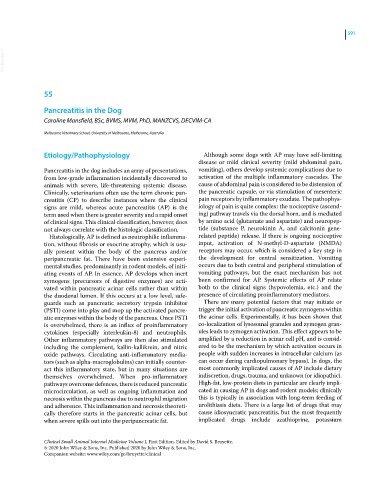Page 623 - Clinical Small Animal Internal Medicine
P. 623
591
VetBooks.ir
55
Pancreatitis in the Dog
Caroline Mansfield, BSc, BVMS, MVM, PhD, MANZCVS, DECVIM-CA
Melbourne Veterinary School, University of Melbourne, Melbourne, Australia
Etiology/Pathophysiology Although some dogs with AP may have self‐limiting
disease or mild clinical severity (mild abdominal pain,
Pancreatitis in the dog includes an array of presentations, vomiting), others develop systemic complications due to
from low‐grade inflammation incidentally discovered to activation of the multiple inflammatory cascades. The
animals with severe, life‐threatening systemic disease. cause of abdominal pain is considered to be distension of
Clinically, veterinarians often use the term chronic pan- the pancreatic capsule, or via stimulation of mesenteric
creatitis (CP) to describe instances where the clinical pain receptors by inflammatory exudate. The pathophys-
signs are mild, whereas acute pancreatitis (AP) is the iology of pain is quite complex: the nociceptive (ascend-
term used when there is greater severity and a rapid onset ing) pathway travels via the dorsal horn, and is mediated
of clinical signs. This clinical classification, however, does by amino acid (glutamate and aspartate) and neuropep-
not always correlate with the histologic classification. tide (substance P, neurokinin A, and calcitonin gene‐
Histologically, AP is defined as neutrophilic inflamma- related peptide) release. If there is ongoing nociceptive
tion, without fibrosis or exocrine atrophy, which is usu- input, activation of N‐methyl‐D‐aspartate (NMDA)
ally present within the body of the pancreas and/or receptors may occur, which is considered a key step in
peripancreatic fat. There have been extensive experi- the development for central sensitization. Vomiting
mental studies, predominantly in rodent models, of initi- occurs due to both central and peripheral stimulation of
ating events of AP. In essence, AP develops when inert vomiting pathways, but the exact mechanism has not
zymogens (precursors of digestive enzymes) are acti- been confirmed for AP. Systemic effects of AP relate
vated within pancreatic acinar cells rather than within both to the clinical signs (hypovolemia, etc.) and the
the duodenal lumen. If this occurs at a low level, safe- presence of circulating proinflammatory mediators.
guards such as pancreatic secretory trypsin inhibitor There are many potential factors that may initiate or
(PSTI) come into play and mop up the activated pancre- trigger the initial activation of pancreatic zymogens within
atic enzymes within the body of the pancreas. Once PSTI the acinar cells. Experimentally, it has been shown that
is overwhelmed, there is an influx of proinflammatory co‐localization of lysosomal granules and zymogen gran-
cytokines (especially interleukin‐8) and neutrophils. ules leads to zymogen activation. This effect appears to be
Other inflammatory pathways are then also stimulated amplified by a reduction in acinar cell pH, and is consid-
including the complement, kallin‐kallikrein, and nitric ered to be the mechanism by which activation occurs in
oxide pathways. Circulating anti-inflammatory media- people with sudden increases in intracellular calcium (as
tors (such as alpha‐macroglobulins) can initially counter- can occur during cardiopulmonary bypass). In dogs, the
act this inflammatory state, but in many situations are most commonly implicated causes of AP include dietary
themselves overwhelmed. When pro-inflammatory indiscretion, drugs, trauma, and unknown (or idiopathic).
pathways overcome defences, there is reduced pancreatic High‐fat, low‐protein diets in particular are clearly impli-
microcirculation, as well as ongoing inflammation and cated in causing AP in dogs and rodent models; clinically
necrosis within the pancreas due to neutrophil migration this is typically in association with long‐term feeding of
and adherence. This inflammation and necrosis theoreti- urolithiasis diets. There is a large list of drugs that may
cally therefore starts in the pancreatic acinar cells, but cause idiosyncratic pancreatitis, but the most frequently
when severe spills out into the peripancreatic fat. implicated drugs include azathioprine, potassium
Clinical Small Animal Internal Medicine Volume I, First Edition. Edited by David S. Bruyette.
© 2020 John Wiley & Sons, Inc. Published 2020 by John Wiley & Sons, Inc.
Companion website: www.wiley.com/go/bruyette/clinical

